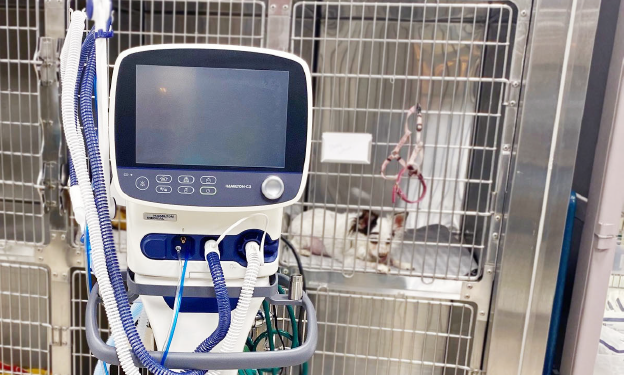Ventilators and the Care Veterinary Patients Require
January 13, 2021
Written by Nan Painter, LVT, VTS ECC
With COVID-19 causing many hospitals to be stretched to capacity, having an understanding of mechanical ventilation is important. The care for patients on a ventilator is similar regardless of species, but there are some differences.
In veterinary medicine, mechanical ventilation is primarily used in an Emergency & Critical Care setting for patients experiencing respiratory failure. Have you ever considered what level of care is required for veterinary patients that need a ventilator?
Veterinary Ventilator Patients Must Be Heavily Sedated or Anesthetized
One major difference between veterinary ventilator patients and human patients is that animals need to be under heavy sedation/anesthesia for them to be receptive to the care they require.
A human can be awake and sitting up and able to communicate with sign language or writing while on a ventilator. But a dog or cat cannot tolerate being mentally aware of having a breathing tube (endotracheal tube) in place. This level of sedation is achieved in a multi-modal approach with several different drug classes with varying effects and side effects. Most of the combinations include:
- Benzodiazepine (which relaxes muscles and relieves some anxiety).
- Anesthetic medications (which work on the central brain and nervous systems).
- Pure MU opioids (which reduce pain).
- Most often, there is also a need for systemic fluid support along with gastrointestinal protectants and antibiotics.
Nursing Care for Veterinary Ventilator Patients
Human patients require less sedation and therefore can partially participate in activities like position changes and passive range of motion. Our pets cannot. Part of the nursing care for veterinary ventilator patients are:
- Position changes
- Muscle massage
- Cushion support
- Passive range of motion to prevent bed sores, joint injuries, muscle strains, and compression of the lungs.
Eyes, Mouth, and Airway
In addition to support for the body, we provide specific care for the eyes, mouth, and airway itself. We lubricate the mouth and eyes to prevent pressure sores/drying injuries that lead to ulcerations and infections. We also provide suction for the endotracheal tube to remove a substance called surfactant that the body makes to lubricate the lungs and flush out any foreign material (such as the endotracheal tube itself). We also replace the endotracheal tube every 24 hours to prevent secondary infection.
Heat Support
Heat support is usually required to one degree or another for our veterinary patients as well. This can often be a simple blanket over the dog or cat or it can be as involved as piping warmed air over their bodies in a constant flow to maintain their core temperature.
Nutritional Support
Nutrition is a foundation for recovery in many aspects. Often, this is achieved with a feeding tube that is inserted from the patient’s nostril down into their stomach and liquid nutrition is provided through that tube. Calculations are made daily to make sure that the patient is receiving their minimum calories needed to maintain bodily function.
When A Veterinary Patient No Longer Needs A Ventilator
What happens after the patient no longer needs the ventilator? Often they are de-escalated in a series of steps, listed below.
- They prove that they can reliably breathe effective on their own.
- They will move to a High Flow oxygen machine, which is warmed and humidified oxygen support.
The rest of their care after being moved to the High Flow oxygen machine begins to be de-escalated in a series as well until they are able to maintain their own body temperature, eat on their own, eliminate on their own, and do not require oxygen support. This de-escalation process can take days to weeks and can be very labor intensive.
There is a lot of care that goes into a veterinary patient who is in need of a ventilator. We hope that this blog has helped inform you of the steps/care necessary while a patient needs one in an animal hospital.